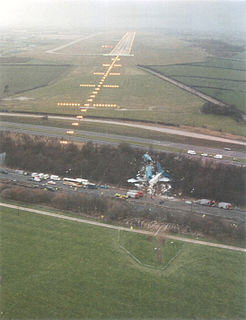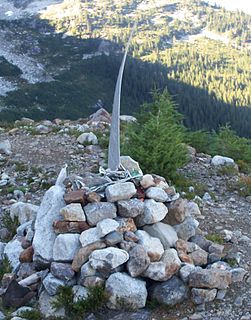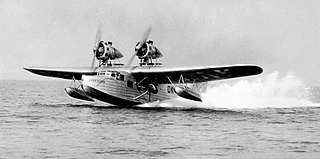
The Saunders-Roe SR.45 Princess was a British flying boat aircraft developed and built by Saunders-Roe at their Cowes facility on the Isle of Wight. It has the distinction of being the largest all-metal flying boat to have ever been constructed.

The Kegworth air disaster occurred when British Midland Airways Flight 092, a Boeing 737-400, crashed onto the motorway embankment between the M1 motorway and A453 road near Kegworth, Leicestershire, England, while attempting to make an emergency landing at East Midlands Airport on 8 January 1989.
This is a list of aviation-related events from 1957:

On 4 June 1967 a Canadair C-4 Argonaut passenger aircraft owned by British Midland Airways crashed near the centre of Stockport, Cheshire, England. Of the 84 people on board, 72 were killed. It is the fourth-worst accident in British aviation history.
Tasman Empire Airways Limited (1940–1965), better known as TEAL, is the former name of Air New Zealand Limited (1965–).

United Air Lines Flight 409 was a scheduled flight which originated in New York City, New York. The final flight destination was San Francisco, California, with stops in Chicago, Denver and Salt Lake City. The aircraft operating the service, a Douglas DC-4 propliner, registration N30062, crashed into Medicine Bow Peak, near Laramie, Wyoming, on October 6, 1955, killing all 66 people on board. The victims included five female members of the Mormon Tabernacle Choir and military personnel. At the time, this was the deadliest airline crash in the history of American commercial aviation. Another 66 lives had been lost earlier that year in the March 22 crash in Hawaii of a United States Navy Douglas R6D-1 Liftmaster military transport aircraft, and 66 had also died in the mid-air collision of two United States Air Force C-119G Flying Boxcars over West Germany on August 11, placing the three crashes in a three-way tie as the deadliest aviation incidents in 1955.

The Short Solent is a passenger flying boat that was produced by Short Brothers in the late 1940s. It was developed from the Short Seaford, itself a development of the Short Sunderland military flying boat design.

Aquila Airways was a British independent airline, formed on 18 May 1948 and based in Southampton, Hampshire.

Pan American World Airways Flight 202 was a Boeing 377 Stratocruiser aircraft that crashed in the Amazon Basin about 281 nautical miles (520 km) southwest of Carolina, Brazil on April 29, 1952. The accident happened en route from Rio de Janeiro, Brazil, to Port of Spain, Trinidad and Tobago, during the third leg of a four-leg journey. All 50 people on board were killed in the deadliest-ever accident involving the Boeing 377.

Trans-Canada Air Lines Flight 810-9 was a Canadair North Star on a scheduled flight from Vancouver to Calgary. The plane crashed into Mount Slesse near Chilliwack, British Columbia, Canada, on 9 December 1956 after encountering severe icing and turbulence over the mountains. All 62 people on board died, making it one of the deadliest airline crashes ever as of that date; it still ranks as the sixth deadliest air disaster in Canadian history.

All Nippon Airways (ANA) Flight 60 was a Boeing 727-81 aircraft making a domestic commercial flight from Sapporo Chitose Airport to Tokyo Haneda International Airport. On February 4, 1966, all 133 people on board died when the plane mysteriously crashed into Tokyo Bay about 10.4 km from Haneda in clear weather conditions while on a night approach. The accident was the worst involving a single aircraft and was also the deadliest accident in Japan at that time until Japan Air Lines Flight 123 crashed 19 years later which killed 520.

Pan Am Flight 7 was a westbound round-the-world flight operated by Pan American World Airways. On November 8, 1957, the Boeing 377 Stratocruiser 10-29 serving the flight, named Clipper Romance of the Skies, crashed in the Pacific Ocean enroute to Honolulu International Airport from San Francisco. The crash killed all 36 passengers and 8 crew members.

The Supermarine Channel was a modified version of the AD Flying Boat, purchased by Supermarine from the British Air Ministry and modified for the civil market with the intention of beginning regular air flights across the English Channel. The aircraft were given airworthiness certificates in July 1919. The Mark I version, later called the Channel I, was powered with a 160 horsepower (120 kW) Beardmore engine; a variant designated as Channel II was fitted with a 240 horsepower (180 kW) Armstrong Siddeley Puma engine. Designed by Supermarine to accommodate up to four passengers, the company produced a series of interchangeable interiors that could be used at short notice, which enabled the Channel to be used as a fighter or for training purposes.
British Aviation Services Limited (Britavia) was an early post-World War II airline holding company and air transport operator that could trace its roots back to 1946. Its main activities included trooping, inclusive tour (IT) and worldwide passenger and freight charter services. British Aviation Services' first investment in a British independent airline occurred in 1946, when it acquired a minority interest in Silver City Airways. Silver City Airways operated the world's first cross-Channel air ferry service on 13 July 1948. It subsequently became British Aviation Services' biggest operating division. In 1953, British Aviation Services took over the independent airline Air Kruise. The same year, BAS Group also took control of Aquila Airways, the last commercial flying boat operator in the United Kingdom. The completion of these acquisitions by mid-1954 resulted in a reorganisation of the British Aviation Services group, with British Aviation Services Ltd becoming the group's holding company and Britavia one of its operating subsidiaries. By the late 1950s, BAS Group became Britain's largest independent airline operator. Its numerous operating divisions included Britavia's Hermes Division at Blackbushe Airport and Aquila Airways's Flying Boat Division at Hamble near Southampton. The former concentrated on trooping services and inclusive tours while the latter provided scheduled services to Portugal, the Canary Islands and Italy. In 1962, BAS Group merged with British United Airways (BUA), which by that time had replaced BAS as the UK's largest independent airline operator.

The Sutton Wick air crash occurred on 5 March 1957 when a Blackburn Beverley C Mk 1 heavy transport aircraft, serial number XH117, of 53 Squadron Royal Air Force crashed at Sutton Wick, Drayton, Berkshire, England, following a shut-down of one engine and partial loss of power on another. Shortly after take-off, No. 1 engine was shut down as a precautionary measure then whilst on final approach back to RAF Abingdon, No. 2 engine failed to respond to throttle inputs. The aeroplane struck cables and trees 18 minutes after lifting off.

The 1929 Imperial Airways Handley Page W.10 crash happened on 17 June 1929 when Handley Page W.10 G-EBMT suffered an engine failure and subsequently ditched in the English Channel off Dungeness with the loss of seven lives. The aircraft was operating an international scheduled flight from Croydon to Le Bourget Airport, Paris, France.

Pan Am Flight 923 was a Douglas DC-4 operating from Seattle, Washington to Juneau, Alaska, which crashed into Tamgas Mountain on Annette Island, Alaska, on October 26, 1947. All 18 passengers and crew on board were killed.

TransAsia Airways Flight 235 was a TransAsia Airways domestic flight from Taipei to Kinmen (Quemoy), Taiwan. On 4 February 2015, the aircraft serving the flight, a 10-month-old ATR 72-600, crashed into the Keelung River shortly after takeoff from Taipei Songshan Airport, 5.4 km to the east of Songshan in Taiwan. The aircraft had 53 passengers and five crew on board; 15 of them survived.

The 1936 Jersey Air Disaster occurred on 31 July 1936 when the Cloud of Iona, a Saro Cloud flying boat operated by Guernsey Airways, ditched into the sea off Jersey, Channel Islands, during a flight between Guernsey and Jersey. Investigators believed that the flying boat failed to reach its destination due to engine failure. All ten on board were assumed to have died.















